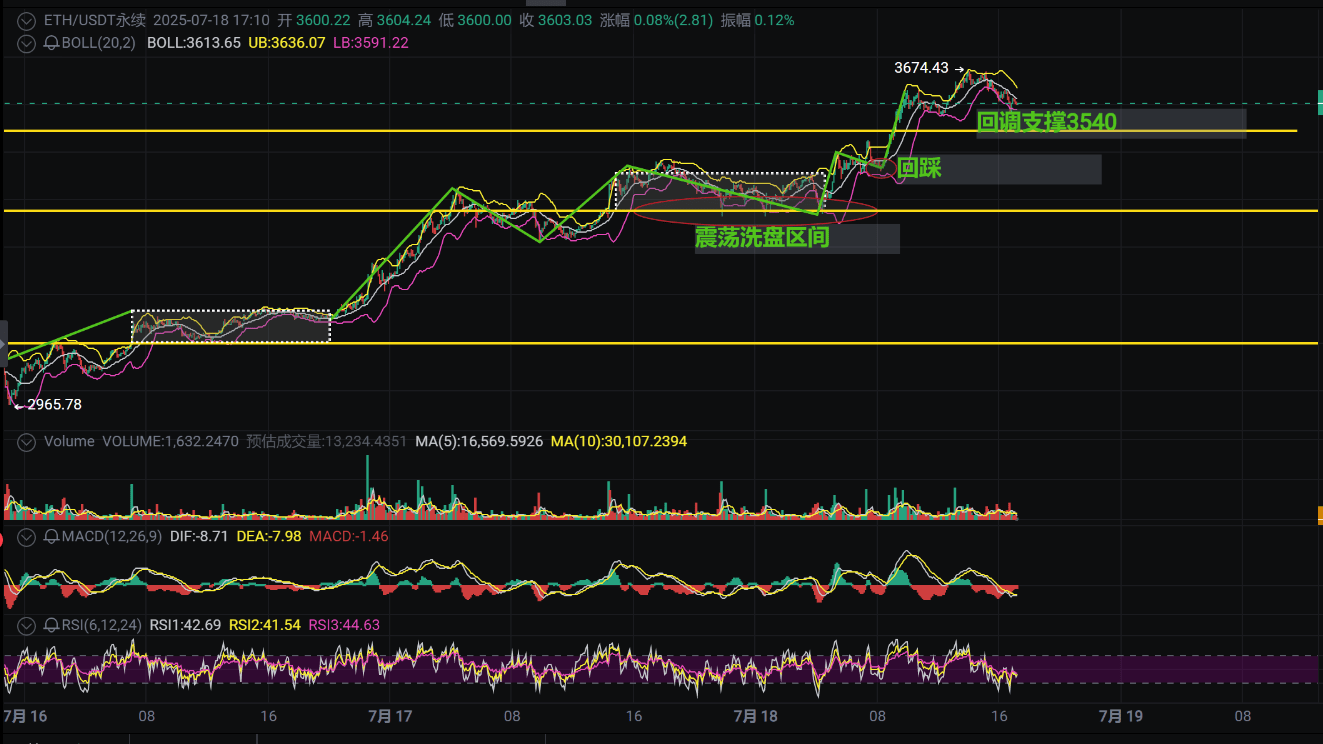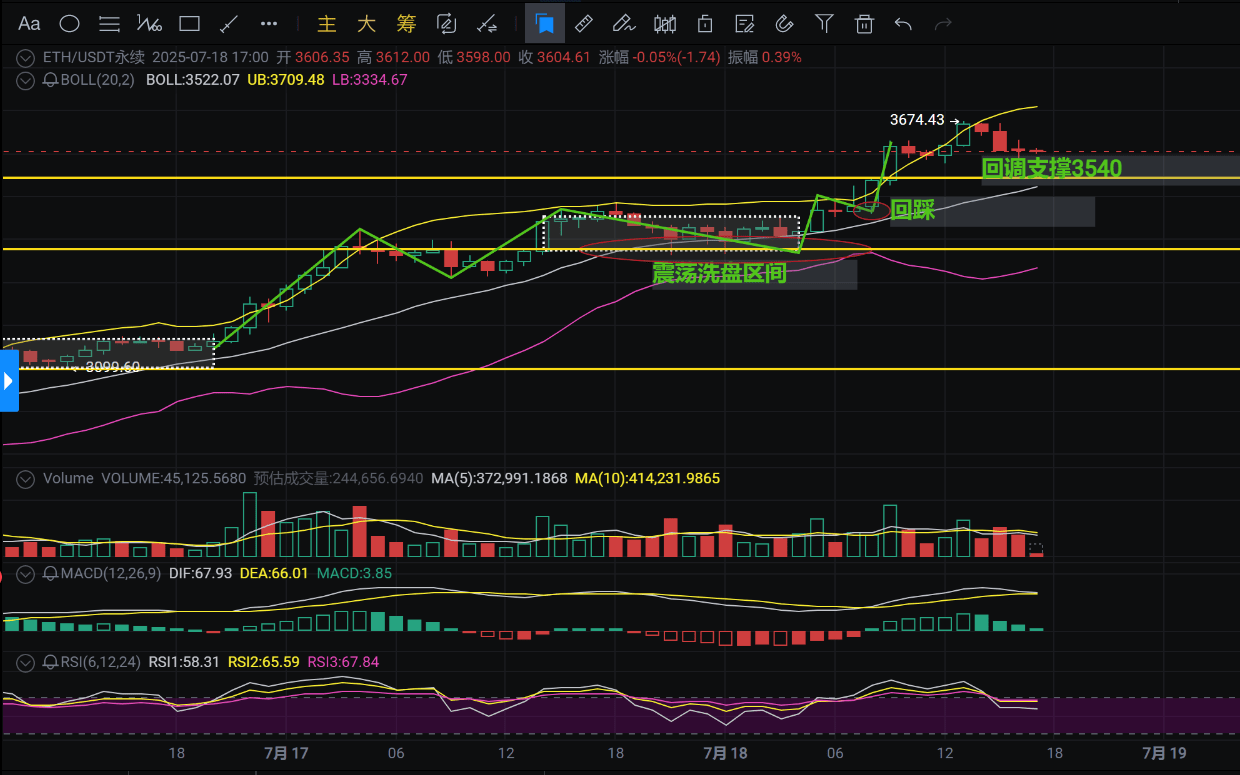The market is like a spring; the tighter it is compressed, the harder it rebounds! But don't rush to bet on the direction, first see who reveals their 'bottom card' first!
Today's ETH is just like a 'tormenting little goblin'—the price is swaying around 3600 USD, with only a 14 USD difference between the highest and lowest in the 1-hour chart, the volatility is as low as a heartbeat about to stop. Market sentiment? Cold enough to freeze: the Bollinger Bands are narrower than a pinhole, the MACD fast and slow lines cling together like twins, the RSI is 'lying flat' between 50-70, and the trading volume has shrunk to a minimum (actual 45k, not even a fraction of the 5-day average). This scene is very much like the calm before the storm— the tighter the spring is compressed, the harder it will bounce back, but the problem is: will it bounce up or smash down?

Key signal breakdown: 3540 and 3674, who is the 'true match'?
Currently, ETH is stuck between the support of 3540 and the pressure of 3674, a literal 'sandwich'. The middle Bollinger Band is at 3522, almost overlapping with the 3540 support, indicating what? 3540 is the 'lifeline'—if it breaks (especially on high volume), the short-term trend may turn weak directly, looking down towards the 'deep pit' of 3334; but if it can hold, like last week, where the price quickly rebounded after dropping to 3550, it shows that the bulls are still 'secretly supporting'.
Now looking at the pressure level of 3674 (close to the upper Bollinger Band at 3709). Here’s a case: last Wednesday, ETH tried to surge to 3680, but was brutally beaten down by bears, smashing back to 3600 with a large bearish candle. Why? Because a breakout must come with volume! At that time, the trading volume was only 60% of the usual, clearly a 'false breakout'. So if it attempts to push 3674 again, we must watch the volume—if it exceeds 500k, or even breaks through 3709, it could quickly reach 3800; but if the volume remains low, it’s likely another 'trap for the bulls'.
The main force is 'washing the positions', retail investors shouldn't be 'cannon fodder'!
The current market is essentially the main force 'shaking the warehouse'—by small fluctuations, it forces indecisive retail investors to give up their chips. For example, yesterday, the price oscillated between 3620 and 3580, resulting in many short-term traders being 'washed' out, and today the price slowly climbed back to 3600. This kind of 'grinding' trend most abhors what? 'Guessing tops and bottoms'! Some people saw the price hovering at 3600 and rushed to short, resulting in a bullish candle that trapped them; others saw support at 3540 and went all in to buy the dip, only to see it break and plunge down.
My opinion is very clear: now is not the time to 'bet on direction', but to 'wait for signals'! Just like in battle, when the enemy is swaying in front of you, rushing out may get you shot by stray arrows; but waiting for them to show a flaw (like breaking through 3674 or falling below 3540), and then attacking in sequence, increases the win rate by at least 50%.

Shencai's advice: bring a small stool to watch the show, wait for the 'rabbit' to hit the tree!
Watch more, act less, don't be the 'bag holder': before the price breaks 3674 or falls below 3540, don't rush to go long or short. In a volatile market, frequent trading will only lead to you being 'beaten from both sides'.
Place orders with 'ambush', but set stop-loss: aggressive friends can place long orders around 3540 or short orders around 3674. But remember, this is 'ambush', not 'charge'—if the price doesn't hit your order, don't chase hard!
Breakout follow-up, steady as an old dog: the safest strategy is to wait for the price to break through 3674 with volume, then go long; or if it breaks down through 3540 with volume, then go short. This is called 'not releasing the hawk until the rabbit appears', although slow, it's safe!
Lastly, a heartfelt note: patience is the sharpest weapon in a volatile market!
Today's ETH is like a boxer waiting to unleash a big move—the tighter the Bollinger Bands, the harder that punch will be. But the question is, is it a fake punch (false breakout) or a real strike (true breakout)? We don't know now, and there's no need to know. Keep a close watch on 3540 and 3674; whoever gets 'breached' (especially with volume), we'll decide whether to 'charge' or 'retreat'.
For now, bring a small stool, brew a cup of tea, and watch the main force perform—wait for clear signals before we 'roll up our sleeves and work hard' together!
If you don't know what an effective breakout is, you can come to Shencai for a hands-on guide.
Are you trapped? When to buy the dip? It's still that saying, if you're confused and helpless about what to do, click on the avatar to comment. I need fans, and you need references.

